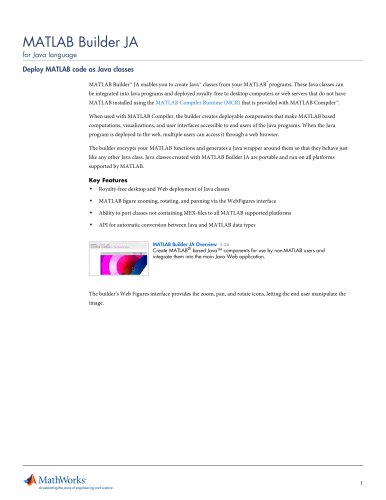
Catalog excerpts
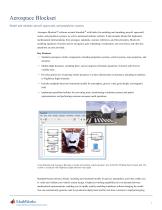
Aerospace Blockset Model and simulate aircraft, spacecraft, and propulsion systems Aerospace Blockset™ software extends Simulink® with blocks for modeling and simulating aircraft, spacecraft, rocket, and propulsion systems, as well as unmanned airborne vehicles. It also includes blocks that implement mathematical representations from aerospace standards, common references, and first principles. Blocks for modeling equations of motion and for navigation, gain scheduling, visualization, unit conversion, and other key operations are also provided. Key Features ▪ Simulates aerospace vehicle components, including propulsion systems, control systems, mass properties, and actuators ▪ Models flight dynamics, including three- and six-degrees-of-freedom equations of motion with fixed or variable mass ▪ Provides options for visualizing vehicle dynamics in a three-dimensional environment, including an interface to FlightGear flight simulator ▪ Includes standards-based environmental models for atmosphere, gravity, wind, geoid height, and magnetic field ▪ Implements predefined utilities for converting units, transforming coordinate systems and spatial representations, and performing common aerospace math operations Using Simulink and Aerospace Blockset to model and simulate vehicle dynamics of a NASA HL-20 lifting body (bottom left). The system is visualized with FlightGear flight simulator (top right). Standards-based reference blocks, including environmental models for gravity, atmosphere, and wind, enable you to verify and validate your vehicle system design. Graphical switching capabilities let you alternate between mathematical representations, enabling you to rapidly modify modeling conditions without changing the model. You can automatically generate code for production deployment and for real-time execution in rapid prototyping
Open the catalog to page 1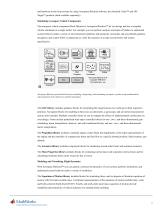
and hardware-in-the-loop systems by using Aerospace Blockset software, the Simulink Coder™ and xPC Target™ products (both available separately). Simulating Aerospace Vehicle Components The aerospace vehicle component block libraries in Aerospace Blockset™ let you design and test a complete vehicle simulation in a single model. For example, you can perform analyses and trade-off studies to understand system behavior under a variety of environmental conditions and parameter constraints and use prebuilt guidance, navigation, and control (GNC) components to verify the response of a radar system...
Open the catalog to page 2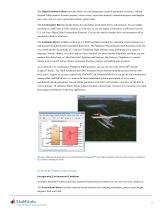
The Flight Parameters library provides blocks for calculating these common parameters: incidence, sideslip, airspeed, Mach number, dynamic pressure, relative ratios, equivalent airspeed, calibrated airspeed, wind angular rate vector, and, for a given geocentric latitude, planet radius. The Aerodynamics library includes blocks for calculating aerodynamic forces and moments. You can supply aerodynamic coefficients in body, stability, or wind axes, or you can import aerodynamic coefficients from the U.S. Air Force Digital Data Compendium (Datcom). You can also specify whether forces and...
Open the catalog to page 3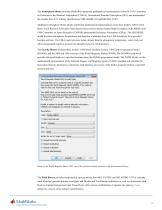
The Atmosphere library provides blocks that implement mathematical representations from the 1976 Committee on Extension to the Standard Atmosphere (COESA), International Standard Atmosphere (ISA), and nonstandard day models from U.S. military specifications (MIL-HDBK-310 and MILSTD-210C). Additional Atmosphere library blocks implement mathematical representations from these models: 2001 United States Naval Research Laboratory Mass Spectrometer and Incoherent Scatter Radar Exosphere (NRLMSISE) and 1986 Committee on Space Research (COSPAR) International Reference Atmosphere (CIRA). The...
Open the catalog to page 4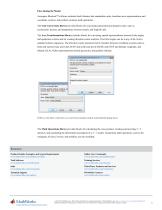
Aerospace Blockset™ software includes block libraries that standardize units, transform axes representations and coordinate systems, and perform common math operations. The Unit Conversions library provides blocks for converting typical physical property units, such as acceleration, density, and temperature, between metric and English units. The Axes Transformations library includes blocks for converting spatial representations between Euler angles and quaternion vectors and for creating direction cosine matrices. The Euler angles can be in any of the twelve standard rotation sequences. The...
Open the catalog to page 5All The MathWorks catalogs and technical brochures
-
MATLAB Production Server
6 Pages
-
Database Toolbox
4 Pages
-
MATLAB Report Generator
4 Pages
-
Stateflow
8 Pages
-
SimEvents
7 Pages
-
SimDriveline
7 Pages
-
SimHydraulics
7 Pages
-
SimPowerSystems
8 Pages
-
Simulink Control Design
5 Pages
-
SimRF
6 Pages
-
Simulink Coder
6 Pages
-
Embedded Coder
8 Pages
-
Simulink PLC Coder
4 Pages
-
Fixed-Point Designer
9 Pages
-
MATLAB Coder
5 Pages
-
Simulink 3D Animation
10 Pages
-
Gauges Blockset
2 Pages
-
Simulink Report Generator
3 Pages
-
Polyspace Bug Finder
6 Pages
-
global-optimization-toolbox
10 Pages
-
Phased Array System Toolbox
9 Pages
-
OPC Toolbox
5 Pages
-
Simulink Design Verifier
7 Pages
-
Simulink Design Optimization
10 Pages
-
Filter Design HDL Coder
5 Pages
-
Bioinformatics Toolbox
9 Pages
-
SimBiology
6 Pages
-
Computer Vision System Toolbox
10 Pages
-
DSP System Toolbox
11 Pages
-
Fuzzy Logic Toolbox
5 Pages
-
Polyspace Client for C/C++
5 Pages
-
xPC Target
5 Pages
-
SimMechanics
7 Pages
-
Simscape
7 Pages
-
Simulink
6 Pages
-
Data Acquisition Toolbox
8 Pages
-
Image Processing Toolbox
7 Pages
-
Signal Processing Toolbox
10 Pages
-
Control System Toolbox
6 Pages
-
Symbolic Math Toolbox?
6 Pages
-
Parallel Computing Toolbox?
7 Pages
-
MATLAB®
6 Pages
-
Mapping Toolbox 3.2
7 Pages
-
Instrument Control Toolbox
7 Pages
-
Optimization Toolbox 6.0
14 Pages
Archived catalogs
-
MATLAB Release Notes
505 Pages
-
C and Fortran API Reference
263 Pages
-
External Interfaces
649 Pages
-
Function Reference: Volume 3 (P-Z)
1696 Pages
-
Function Reference: Volume 2 (F-O)
1568 Pages
-
Function Reference: Volume 1 (A-E)
1298 Pages
-
Creating Graphical User Interfaces
520 Pages
-
3-D Visualization
212 Pages
-
Graphics
667 Pages
-
MATLAB Programming Tips
66 Pages
-
Programming Fundamentals
840 Pages
-
Data Analysis
220 Pages
-
Mathematics
316 Pages
-
MATLAB® Getting Started Guide
250 Pages



